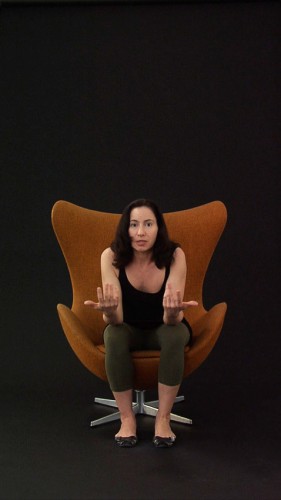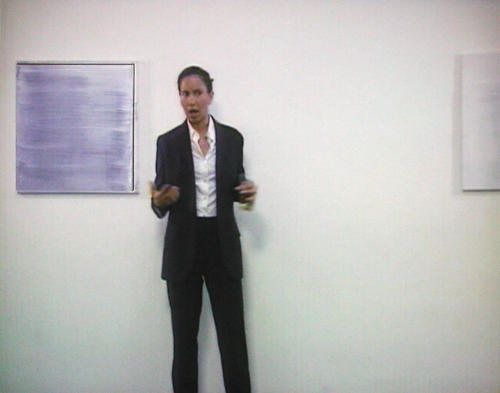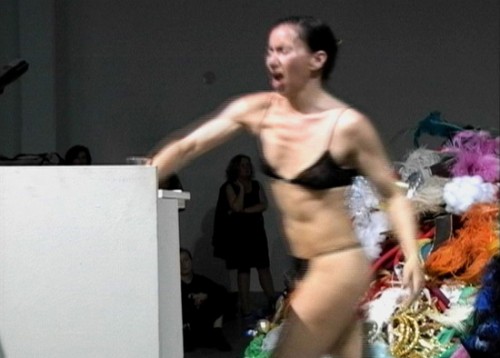
Andrea Fraser. "Museum Highlights: A Gallery Talk", 1989. Video still of performance. Courtesy UCLA.
This week, Andrea Fraser premiered her new performance Men on the Line, KPFK, 1972 in which she reenacts an eponymous LA public radio program from forty years ago. Clad in a masculine shirt and pants, Fraser embodies the voices of four men: Lee Chrismier, Bob Keneger, Jeremy Shapiro, and moderator Everett Frost as they discuss their positions as male feminists and active supporters of the Women’s Movement.
Fraser’s Men on the Line represents part of the Pacific Standard Time: Art in L.A. 1945–1980 Performance and Public Art Festival. Of course, the timeframe of PST underscores the historical focus of the Performance and Public Art Festival—meaning that most of the works are reenactments or reinterpretations of earlier pieces, as Catherine Wagley cited earlier this month in her most recent Looking at Los Angeles post. But unlike Suzanne Lacy’s Three Weeks in January/ Three Weeks in May piece or Liz Glynn’s Spirit Resurrection performance series, Fraser’s Men on the Line reframes a non-art event in the context of performance art. While the themes of Men on the Line relate to Fraser’s canon of institutional critique-based works, the gesture of transcribing and re-performing this radio conversation aligns with the artist’s more recent video piece, Projection. For the latter piece, Fraser documented, transcribed, performed, and edited an intense series of psychoanalytic sessions, embodying her therapist and re-embodying herself as the patient. Moreover, it is distinct from works such as Official Welcome and Untitled in its separation from themes such as art elitism, classism, and ageism—focusing more narrowly on gender and the shifting efforts of feminism.

Andrea Fraser. "Projection," 2008. Two channel, high definition video projection, 50 minutes. Courtesy Friedrich Petzel Gallery.
Fraser is one of several artists who are creating and staging pieces in response to the legacy of Los Angeles’ Woman’s Building as part of a series curated by West of Rome director Emi Fontana. In this piece Fraser maintains an indirect relationship with the art world, selecting a conversation that occurred the year before Judy Chicago, Sheila Levrant de Bretteville and Arlene Raven defected from CalArts to found the Feminist Studio Workshop and establish their alternative school at the Woman’s Building. The conversation opens with the men responding to the words of Judy Chicago herself, and participant Jeremy Shapiro is introduced as a professor at CalArts. Shapiro is presumably a colleague of Chicago’s, and he is participating in this conversation at the very moment in time that Chicago and her female compatriots are reaching a breaking point, on the verge of founding their own women-only art program. This timing adds yet another level of irony to Fraser’s characteristically satirical tone. Still, Fraser has a knack for balancing a humorous tongue-in-cheek attitude with emotional weight and sincerity.
Fraser is a riveting performer, which is also what makes her a great teacher. While studying with her in graduate school, I discovered that even in pedagogical settings, Fraser radiates the same charisma that she brings to the stage. Moreover, there is a certain richness that saturates her voice and resonates hypnotically—even when she affects other personas. Indeed, Fraser’s subtle drag serves as a fantastic device for embodying the way in which her male characters strain to empathize with the women in their world, and transcend their once-familiar gender roles.

Andrea Fraser. "Art Must Hang (Kunst Muss Hängen)," 2001. Video still. Courtesy Friedrich Petzel Gallery.
Of course the work’s ultimate success relies on the way Fraser uses the conversation to revisit issues of male/female relationships, and to evaluate the progress of feminism. While many of the ideas discussed seem almost quaint, countless other of the issues broached remain unsolved dilemmas in the ongoing fight for gender equality. Though I know my position in society is already much more privileged than that of my foremothers, I still see marks of chauvinism and misogyny throughout our culture, even among my male friends who claim to be sympathetic to feminism.
Fraser’s piece closes with one of the men describing how feminism has changed his relationship to other men, for the better. Choking back tears, he tells us, “[Now] I can put my arms around another man, and say, ‘I like you.’” Yet, forty years later, I still don’t know many men who would engage in such behavior without being laughed at. Indeed we are still struggling not only for women’s liberation, but the liberation of all genders. By and large, men are still the ones with the most power and privilege. Fraser’s piece left me vacillating between feelings of bitterness for the stunted progress of feminism, and a deep sympathy for my male allies. It’s certainly a fine line.

Andrea Fraser. "Official Welcome," 2001-2003. Video still of performance. Courtesy UCLA.



